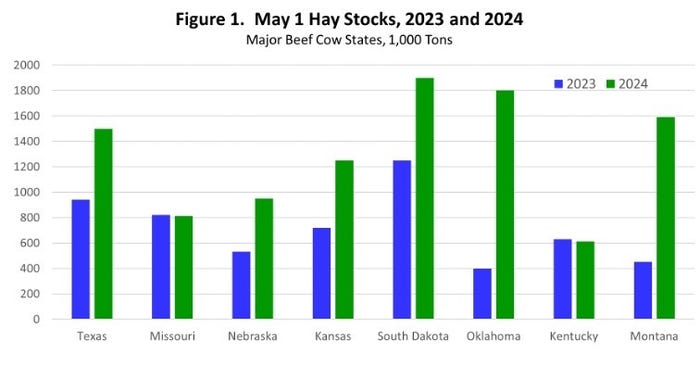Derrell Peel: So far so good, but be cautious of 2024 pasture and hay conditions
Posted on May 21, 2024
Source: Farm Progress. The original article is posted here.

Figure 1 shows the May 1 hay stocks for the eight largest beef cow states. These states represent just over 51 percent of the total beef cow inventory of the country. May 1 hay stocks in the states in Figure 1 were mostly higher year over year, some significantly higher. Only Missouri and Kentucky had fractionally lower hays stocks this year. Hay stocks in these eight states are collectively up 81.4 percent year over year and are 9.4 percent above the ten-year average. These major beef cow states accounted for 54.0 percent of the total U.S. May1 hay stocks.

May 1 is also when USDA-NASS begins the seasonal reports on pasture and range conditions. The second report of the year for May 13 shows that the percent of U.S. pastures and ranges in poor to very poor condition was 24 percent, compared to 33 percent at the same time one year ago. At the other end of the scale, 47 percent of pastures and ranges are currently rated in good to excellent condition, compared to 34 percent last year. Regional pasture and range conditions show significant improvement year over year.
The Great Plains, including Kansas, Colorado, Nebraska, Wyoming, Montana, and North and South Dakota, have 12.29 percent of pastures and ranges in poor to very poor condition, compared to 31.29 percent one year ago. The Southern Plains, consisting of Oklahoma and Texas, have 26.5 percent of pastures in poor to very poor condition this year, compared to 47.5 percent last year. The eight states west of the Great Plains region have 14.63 percent of pastures and ranges in poor to very poor condition, compared to 20.5 percent one year ago.
The U.S. currently has less drought than anytime in the last four years. The Drought Monitor includes the Drought Severity and Coverage Index (DSCI), which combines the drought categories in the Drought Monitor into a single drought measure. The DSCI can take on values from zero to 500 and the current value of 51 is the lowest DSCI since April 2020. The DSCI reached a recent peak of 202 in late 2022.
Conditions at the beginning of the 2024 forage growing season suggest that producers may be able to plan grazing and hay production with less restriction compared to recent years. However, in many cases, pastures and ranges still need time to recover from extended drought conditions. There is reason to be cautiously optimistic for better cattle production conditions in 2024.
However, the forecasted redevelopment of La Niña conditions this summer is worrisome. The seasonal forecast from the Climate Prediction Center is for above average temperatures and below average precipitation for the next three months in much of major beef cattle country. Proceed with caution.

.jpg?disable=upscale&width=1200&height=630&fit=crop)


